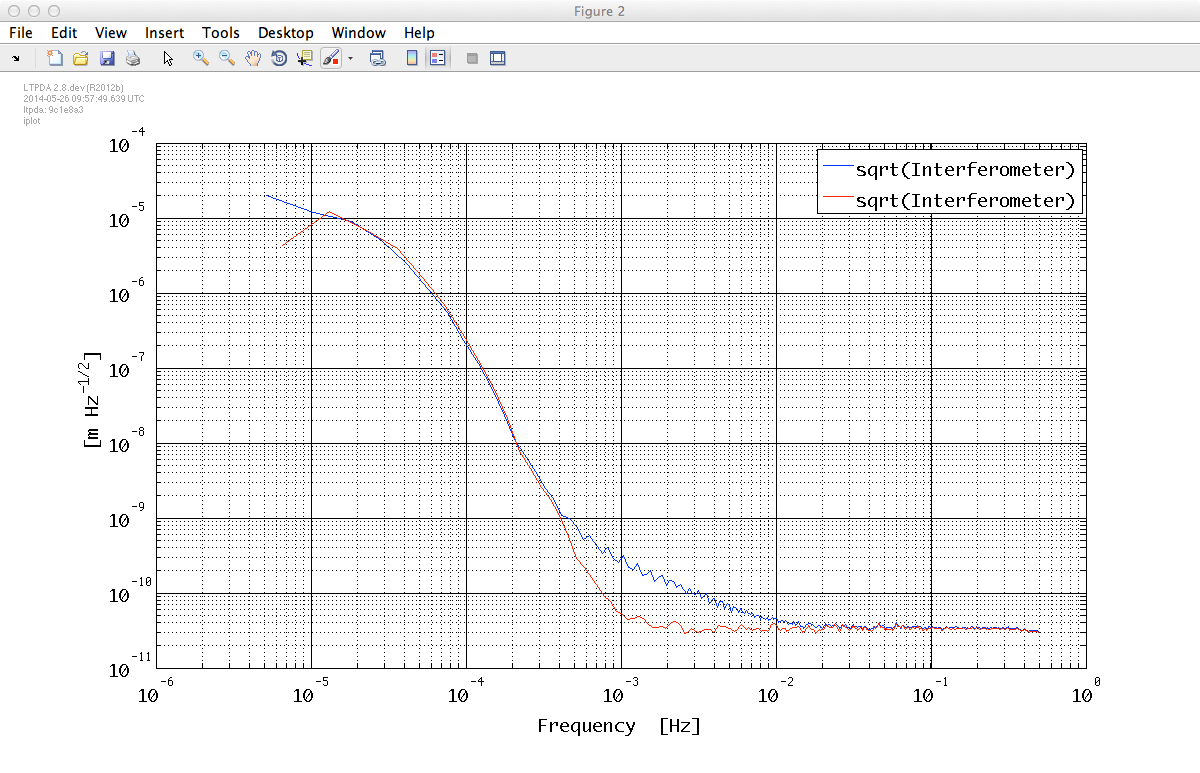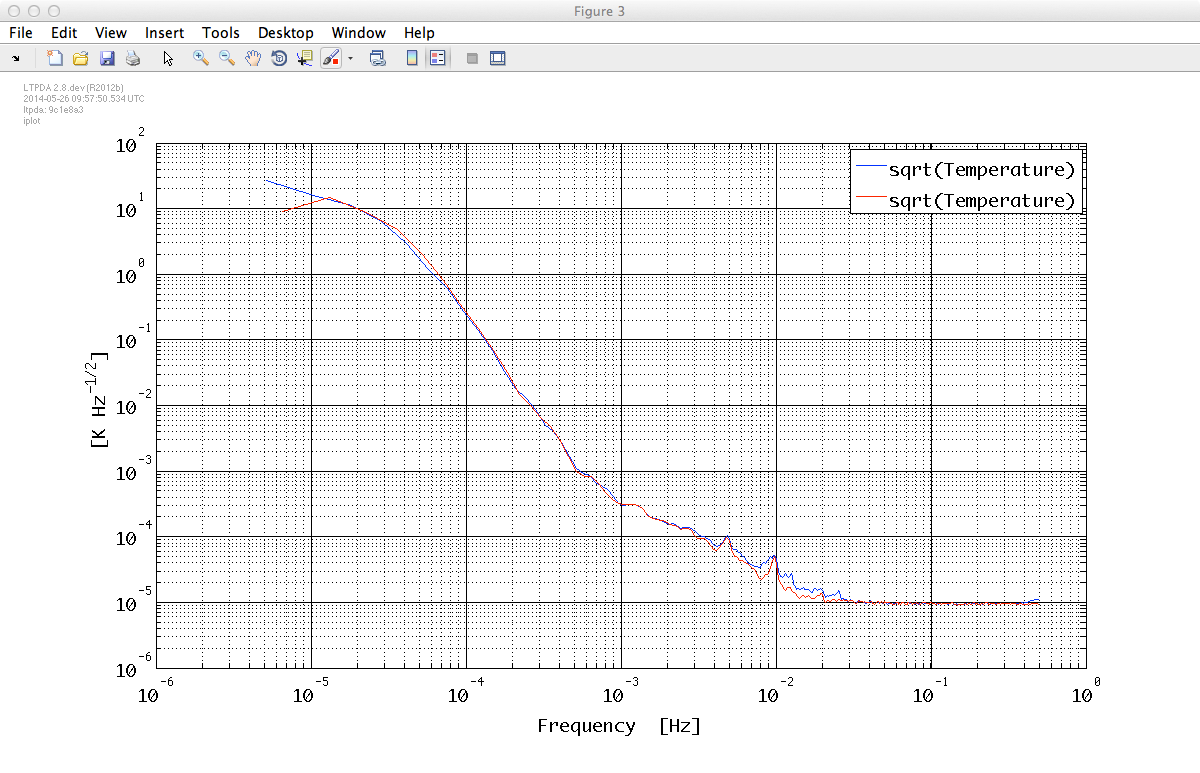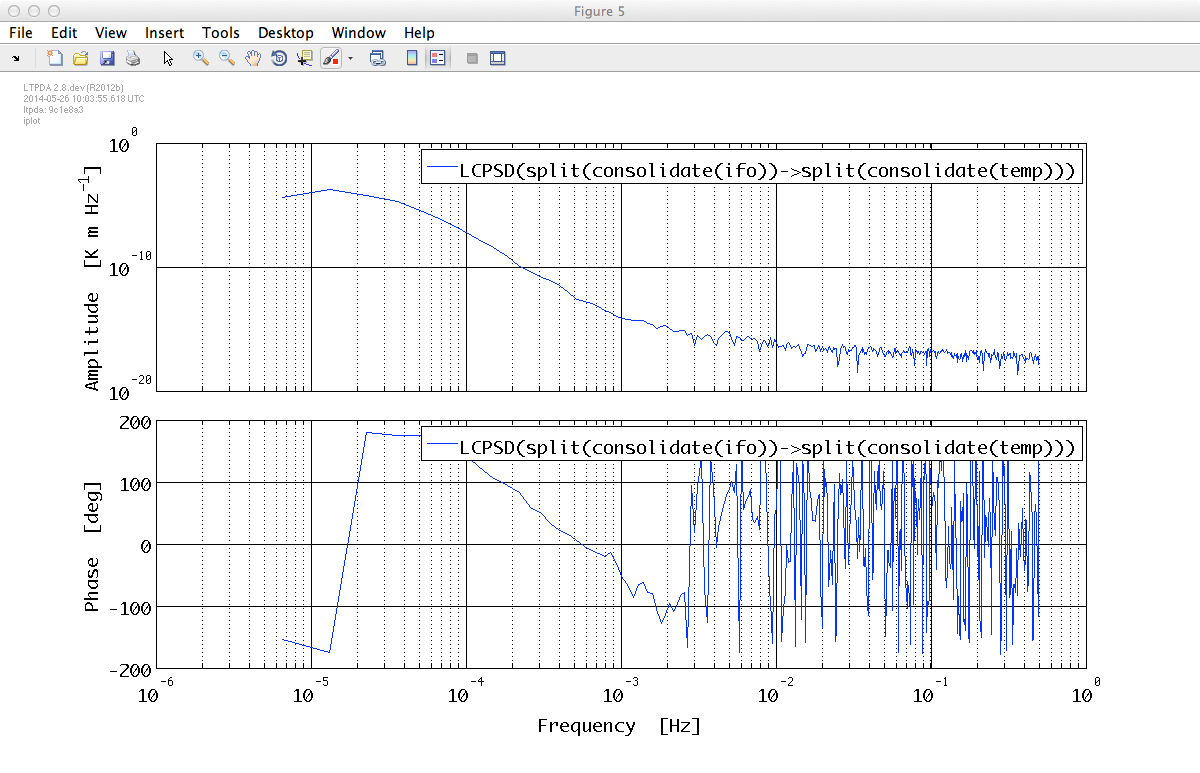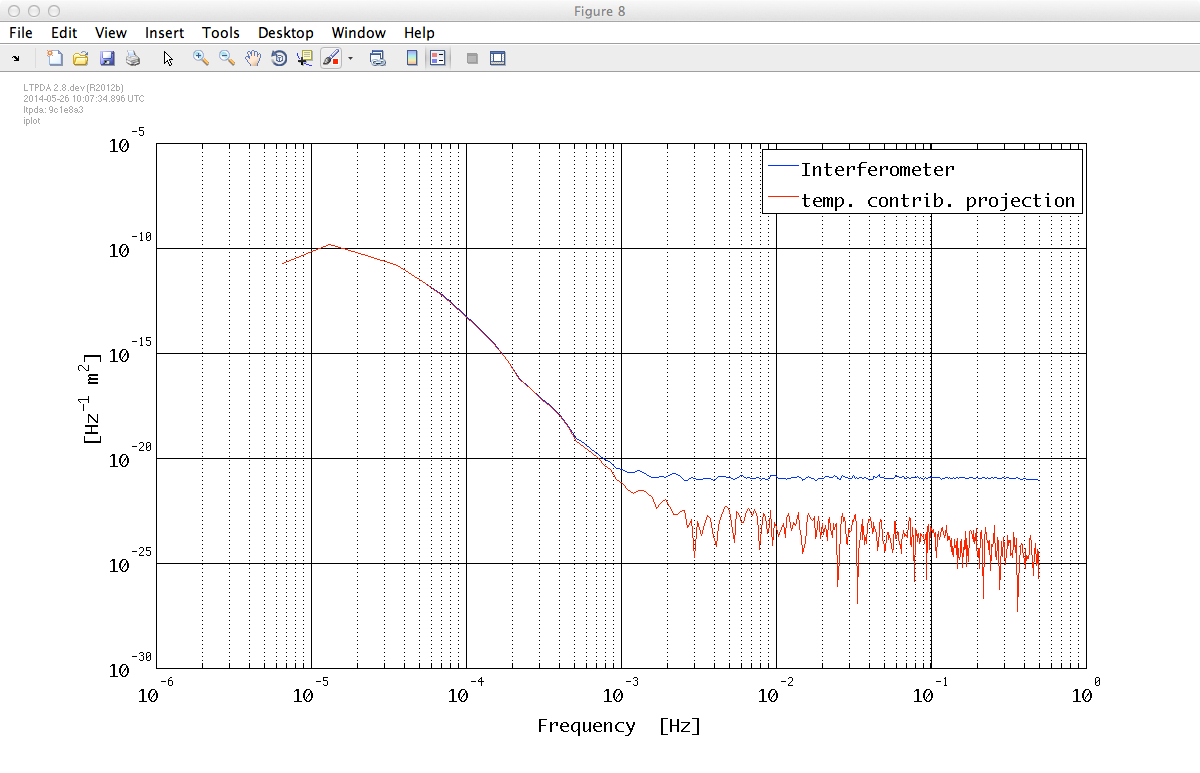

| LTPDA Toolbox™ | contents |   |
In order to proceed with the spectral analysis, we need to use the ao constuctor, with the set of parameters "From XML File". The key parameters are:
| Key | Value | Description |
|---|---|---|
|
FILENAME |
'ifo_temp_example/ifo_fixed.xml' |
The name of the file to read the data from. |
|
FILENAME |
'ifo_temp_example/temp_fixed.xml' |
The name of the file to read the data from. |
Hint: the command-line sequence may be similar to the following:
%% Get the consolidated data % Using the xml format T_filename = 'ifo_temp_example/temp_fixed.xml'; x_filename = 'ifo_temp_example/ifo_fixed.xml'; pl_load_T = plist('filename', T_filename); pl_load_x = plist('filename', x_filename); % Build the data aos T = ao(pl_load_T); x = ao(pl_load_x);
To perform the PSD estimation, you can use the method
| ao/lpsd |
Hint: the command-line sequence may be similar to the following:
%% PSD x_psd = lpsd(x) x_psd.setName('Interferometer'); T_psd = lpsd(T) T_psd.setName('Temperature'); % Plot estimated PSD pl_plot = plist('Arrangement', 'subplots', 'LineStyles', {'-','-'},'Linecolors', {'b', 'r'}); iplot(sqrt(x_psd), sqrt(T_psd), pl_plot);
Looking at the output of the analysis it is easy to recognize in the IFO PSD the signature of some strong "spike" in the data. Indeed, if we plot the x data, we can find it around t = 40800. There is also a leftover from the filtering process performed during consolidation right near to the last data.
We can then try to estimate the impact of the "glitch" by comparing the results we obtain by passing to ao/lpsd a reduced fraction of the data.
In order to select a fraction of the data we use the method:
| ao/split |
The relevant parameters for this method are listed here, together with their recommended values:
| Key | Value | Description |
|---|---|---|
|
SPLIT_TYPE |
'interval' |
The method for splitting the ao |
|
START_TIME |
x.t0 + 40800 |
A time-object to start at |
|
END_TIME |
x.t0 + 193500 |
A time-object to end at |
Notice that in order to perform this action, we access one property of the ao object, called "t0". The call to the t0 methods gives as an output an object of the time class. Additionally, it's possibly to directly add a numer (in seconds) to obtain a new time object.
Hint: the command-line sequence may be similar to the following:
%% Skip some IFO glitch from the consolidation pl_split = plist('start_time', x.t0 + 40800, ... 'end_time', x.t0 + 193500); x_red = split(x, pl_split); T_red = split(T, pl_split);
Note: you can also use the parameter 'times' for split to specify times relative to the first sample.
In this case:
plist('times', [40800 193500]).
|
And we can proceed, evaluating 2 more aos to compare the effect of skipping the "glitch". After doing that, we can plot them in comparison.
Hint:
%% PSD x_red_psd = lpsd(x_red); x_red_psd.setName('Interferometer'); T_red_psd = lpsd(T_red) T_red_psd.setName('Temperature'); % Plot estimated PSD pl_plot = plist('Arrangement', 'stacked', 'LineStyles', {'-','-'},'Linecolors', {'b', 'r'}); iplot(sqrt(x_psd), sqrt(x_red_psd), pl_plot); iplot(sqrt(T_psd), sqrt(T_red_psd), pl_plot);


We can now proceed and use the
| ao/lcpsd |
Hint:
%% CPSD estimate CTx = lcpsd(T_red, x_red); CxT = lcpsd(x_red, T_red); % Plot estimated CPSD iplot(CTx); iplot(CxT);


As expected, there is a strong low-frequency correlation between the IFO data x and the temperature data T.
Similarly, we can now proceed and use the
| ao/lcohere |
%% Coherence estimate coh = lcohere(T_red, x_red); % Plot estimated cross-coherence iplot(coh, plist('YScales', 'lin'))

The coherence approaches 1 at low frequency.
We want now to perform noise projection, trying to estimate the transfer function of the temperature signal into the interferometer output. In order to do that, we can use the
| ao/ltfe |
We also want to plot this transfer function to check that the units are correct.
Hint:
%% transfer function estimate tf = ltfe(T_red, x_red) % Plot estimated TF iplot(tf);

As expected, the transfer function T -> IFO is well measured at low frequencies.
We can eventually perform the noise projection, estimating the amount of the noise in the IFO being actually caused by temperature fluctuations. It's a frequency domain estimate:
%% Noise projection in frequency domain proj = T_red_psd .* (abs(tf)).^2; proj.simplifyYunits; proj.setName('temp. contrib. projection') %% Plotting the noise projection in frequency domain iplot(x_red_psd, proj);
The contribution of the temperature fluctuations is clearly estimated.

Let's fininsh this section of the exercise by saving the results on disk, in xml or mat format. We want to keep the results about the Power Spectral Density and Transfer Function Estimates, at least.
Hint: the command-line sequence may be similar to the following:
%% Save the PSD data % xml format pl_save_x_PSD = plist('filename', 'ifo_temp_example/ifo_psd.xml'); pl_save_T_PSD = plist('filename', 'ifo_temp_example/T_psd.xml'); pl_save_xT_CPSD = plist('filename', 'ifo_temp_example/ifo_T_cpsd.xml'); pl_save_xT_cohere = plist('filename', 'ifo_temp_example/ifo_T_cohere.xml'); pl_save_xT_TFE = plist('filename', 'ifo_temp_example/T_ifo_tf.xml');
or
% mat format pl_save_x_PSD = plist('filename', 'ifo_temp_example/ifo_psd.mat'); pl_save_T_PSD = plist('filename', 'ifo_temp_example/T_psd.mat'); pl_save_xT_CPSD = plist('filename', 'ifo_temp_example/ifo_T_cpsd.mat'); pl_save_xT_cohere = plist('filename', 'ifo_temp_example/ifo_T_cohere.mat'); pl_save_xT_TFE = plist('filename', 'ifo_temp_example/T_ifo_tf.mat');
and
% Save
x_red_psd.save(pl_save_x_PSD);
T_red_psd.save(pl_save_T_PSD);
CxT.save(pl_save_xT_CPSD);
coh.save(pl_save_xT_cohere);
tf.save(pl_save_xT_TFE); |
Empirical Transfer Function estimation | Topic 4 - Transfer function models and digital filtering |  |
©LTP Team